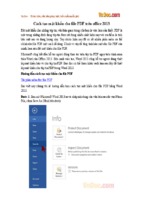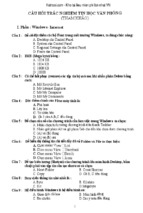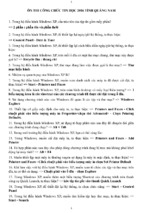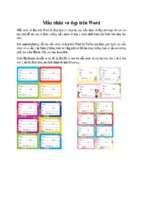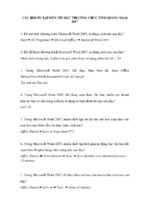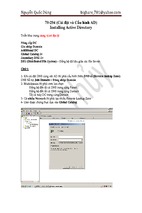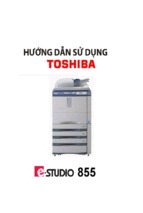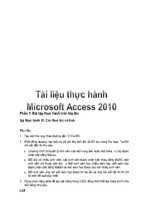macromedia_flash_mx_2004_and_video
Macromedia Flash MX 2004 and Video
by Forest Key and Chris Hock
February 2004
by Forest Key and Chris Hock
Copyright © 2004 Macromedia, Inc. All rights reserved.
The information contained in this document represents the current view of Macromedia on the issue discussed as of the date of publication. Because
Macromedia must respond to changing market conditions, it should not be interpreted to be a commitment on the part of Macromedia, and Macromedia
cannot guarantee the accuracy of any information presented after the date of publication.
This white paper is for information purposes only. MACROMEDIA MAKES NO WARRANTIES, EXPRESS OR IMPLIED, IN THIS DOCUMENT.
Macromedia may have patents, patent applications, trademark, copyright or other intellectual property rights covering the subject matter of this
document. Except as expressly provided in any written license agreement from Macromedia, the furnishing of this document does not give you any
license to these patents, trademarks, copyrights or other intellectual property.
Macromedia®, Macromedia Director, Macromedia Flash Communication Server, and Macromedia Flash® are either trademarks or registered
trademarks of Macromedia, Inc. in the United States and/or other countries. The names of actual companies and products mentioned herein may be the
trademarks of their respective owners.
Macromedia, Inc.
600 Townsend Street, Suite 500
San Francisco, CA 94103
415–252–2000
Contents
Executive Summary ............................................................................................................... 1
Introduction............................................................................................................................. 1
Macromedia Flash and Flash Video..................................................................1
Technical Overview of Video Standards .............................................................2
Video Standards—NTSC and PAL ...............................................................2
Interlaced and Progressive Video ................................................................5
Introducing the Macromedia Flash MX 2004 Video Platform ........................................ 6
Approaches to Incorporating Video ..................................................................6
Embedding Video within Flash Player Movies ................................................7
Producing Progressive FLV Files .................................................................7
Producing Streaming FLV Files ..................................................................8
Using Live Video........................................................................................ 11
Creating Flash Video Files from within Third -Party Applications.....................................11
Using Flash Video Exporter in Demo Mode ...................................................... 12
Supported Third-Party Applications ............................................................... 12
Using the Flash Video Exporter Plug-in........................................................... 13
Encoding Method .................................................................................. 14
Frames Per Second................................................................................ 14
Quality ............................................................................................... 15
Limit Data Rate To................................................................................ 15
Keyframes ........................................................................................... 16
Motion Estimation................................................................................. 17
Audio Bitrate ....................................................................................... 17
Resize To............................................................................................. 17
De-interlacing ...................................................................................... 18
Using Flash Video Exporter from within Third-Party Applications ......................... 18
Adobe After Effects................................................................................ 18
Apple Final Cut Pro............................................................................... 19
Apple QuickTime Player (Mac OS and Windows)........................................... 19
Avid Media Composer and Xpress............................................................. 20
Anystream Agility.................................................................................. 21
Canopus Procoder 2.0............................................................................ 21
Discreet Cleaner (Mac OS)....................................................................... 22
Discreet Cleaner XL (Windows)................................................................. 23
Other Third-Party Products That Support the FLV File Format ........................ 24
Macromedia Flash MX 2004 Video FAQ .........................................................................25
Flash Communication Server Streaming Questions........................................... 27
Macromedia Director MX and Flash Video....................................................... 29
by Forest Key and Chris Hock
Executive Summary
This white paper provides a general overview of the video
capabilities of the Macromedia Flash MX 2004 platform.
Introduction
Video and the Internet seem like a match made in heaven. Video is the rich
media medium that most closely simulates our day-to-day visual
experiences. The Internet is a boundless playground to search for and
consume interesting content. Thousands of compelling websites should
integrate video with data, content and interactive controls to create rich
experiences that go way beyond what is possible with a static television
set… right?
Unfortunately early video content on the web has tended to be very static
and television like—a rectangle of content playing back on your computer
monitor, usually in a separate pop-up window covering the website pages
that spawned it. The images were small, ugly, and the overall experience
was poor.
Several technical challenges have kept designers from fully leveraging video
content, including:
n
n
n
Bandwidth limitations. Video is a data-intensive format, requiring
megabytes of data to display even short video clips of less than one
minute in length. The growth of broadband has greatly alleviated this
technical obstacle, and increasingly large numbers of users have the
bandwidth required to receive video content via the web.
Complexity of authoring video for the web. There have been no
standard tool sets to allow for creation of interactivity, navigation control,
and fusion of video with other rich media content. Furthermore, most
video playback clients are not pre-installed on most end users' systems,
requiring lengthy downloads and a break in the overall immersive
experience when visiting a website.
Lack of compelling integration of video and other web content. Most
video formats for the web offer no rich media capabilities beyond
playback and display of video in a rectangular window. Video on the web
needs to go beyond the television concept!
Macromedia Flash and Flash Video
Flash offers technological and creative benefits that free designers to create
immersive rich experiences that fuse video together with data, graphics,
sound, and dynamic interactive control. The advantages of using Flash
include:
1
by Forest Key and Chris Hock
n
n
n
Immersive experiences. Flash Video is just another media type within
the Flash movie, allowing video to be layered, scripted, and controlled
just like any other object in the Flash movie. Flash Video is an integral
part of the experience, as opposed to a separate pop-up window that
interrupts the viewing experience!
Custom branding and programmability. Flash Video can easily be
reskinned to convey custom branding and unique controls, and can
dynamically adapt based on data-driven content (playlist, closed
captioning, navigation, meta data, and so on).
Ubiquity. Flash Video was introduced with Macromedia Flash Player 6 in
the spring of 2002. Since then, Flash Player has become the most widely
installed Internet video client, running over 90 percent of all Internetconnected PCs (source: NPD research April 2003). By comparison,
Windows Media Player and Real Player have less than 60 percent market
penetration, and QuickTime Player has less than 40 percent. This
ubiquity ensures that Flash websites that use video will load quickly,
with no need for additional plug-in downloads.
Technical Overview of Video Standards
Many people creating Flash Video projects files have a background in web
design and desktop publishing, and might not have the technical
understanding of video necessary to achieve optimal image quality for their
video projects. This section explains the basic concepts and usage of video
parameters and standards. If you are already familiar with these standards
and the terminology, you can skip this section and continue with the
section "Introducing the Macromedia Flash MX 2004 Video Platform."
Video Standards—NTSC and PAL
The video that you see on your television screen follows standards
established in the 1950s when color television was first introduced. The
leading formats in use today are NTSC (National Television System
Committee) and PAL (Phase Alternating Line). Generally speaking, NTSC is
the standard used in the Americas and Japan, whereas PAL is used in
Europe, Australia, the Middle East, and Asi a.
Neither video standard is optimal for presentation on computer monitors;
each poses different challenges when you are trying to optimize video for
web delivery:
n
n
n
n
Frame Size: NTSC and PAL have different image sizes, which differ from
the available image sizes of computer monitors.
Frame Rate: NTSC and PAL have different frame rates for the display of
images, which are different than those used by computer monitors.
Pixel Aspect Ratio: NTSC and PAL share a pixel aspect ratio (referred to
as D1 Aspect Ratio, which is essentially rectangular), but this ratio differs
from that used by computer monitors (which is square).
Display: NTSC and PAL consist of two separate “interlaced” fields, while
computer monitors display “progressive” images.
2
by Forest Key and Chris Hock
Table 1 provides an overview of the differences between these standards.
Table 1: Video Standards at a Glance
Image Size
Frame Rate
Aspect Ratio
Display
NTSC
720 x 480
29.97
D1
Interlaced
PAL
720 x 576
25
D1
Interlaced
Computer
Varies
(much larger)
--
Square
Progressive
Frame Size
Conventional television screens are made up of horizontal lines while
computer monitors consist of a series of horizontal and vertical pixels. The
standard line resolution for an NTSC television is 525 lines; for PAL it is 576
lines. Most modern computer monitors have much higher vertical
resolutions (measured in pixels), such as 768 or 1024, requiring vertical
upscaling during playback in order to fill the monitor.
For NTSC video images, the SMPTE 259M professional standard specifies
that the 525 lines be represented as 720 x 486—that is, 720 horizontal
pixels by 486 vertical pixels. This default video size is commonly known as
D1. Capturing footage with most modern video capture cards from a
professional BetaSP or Digital Betacam source result in a D1-sized frame.
Capturing footage from a DV source, however, yields a 720 x 480 frame. The
difference between the D1 spec and the DV spec is only 6 vertical pixels.
Many compression algorithms, including DV compression, prefer image
sizes to be a multiple of 16. By shaving off the 6 pixels from a D1 resolution,
the DV format was able to have a native resolution with a multiple of 16.
For PAL video images, frames are always 720 x 576, regardless of video
source. Because PAL’s vertical resolution, 576, is a mul tiple of 16, no
change is necessary for DV compression.
Frame Rate
Video is essentially a sequence of images flashed on the screen in rapid
succession, giving the illusion of motion. The number of frames displayed
every second is known as the frame rate, and it is measured in frames per
second (fps). The higher the frame rate, the more frames per second will be
used to display the sequence of images, resulting in smoother motion. The
trade-off, however, is that higher frame rates require a higher amount of
data—or system bandwidth —to display the video.
In a broad sense, NTSC video runs at 30 fps, and PAL runs at 25 fps. In
actuality NTSC runs at 29.97 fps. The reason for the odd frame rate dates
back to the transition from black and white television to color TV signals,
where the 29.97 fps rate was chosen to ensure backwards compatibility
with existing television sets. The fractional rate is more of a mathematical
issue than anything else—there are still 30 frames, but they run 0.1 percent
slower than actual time, giving you a frame rate of 29.97 fps.
3
by Forest Key and Chris Hock
When working with compressed movies in a format like Flash Video, the
more frames that have to be displayed in a second the higher the file size.
To manage the final file size, you have to lower either the frame rate or data
rate. If you lower the data rate and leave the frame rate unchanged, the
image quality is reduced to yield a smaller file size. If you lower the frame
rate and leave the data rate unchanged, the file size is reduced but the
movie might appear to stutter and motion may look less fluid than desired.
Whenever the frame rate is reduced, it is always a good idea to use an
evenly divisible ratio of the original frame rate. If your source has a frame
rate of 24 fps, then you should drop the frame rate to 12 fps, 8 fps, 6 fps, 4
fps, 3 fps, or 2 fps. If the source frame rate is 30 fps, in most cases you can
adjust the frame rate to 30 fps, 15 fps, 10 fps, 6 fps, and so on. If your video
is more than 10 minutes long, then audio will drift noticeably out of synch if
you do not adhere to the 29.97 fps rate or an accurate even division for
lower frame rates (such as 29.97/2 = 14.98).
Pixel Aspect Ratio
The D1/DV NTSC and PAL specification specify non -square pixels (often
called D1 aspect ratio), while computer monitor pixels are square. D1 pixels
are vertically shorter. For this reason when looking at a D1 video image on a
computer monitor, the images will appear to be squashed vertically—
making actors appear to be shorter. When this image is output and
displayed on a broadcast monitor, the pixels are wider than they are tall
and will show perfectly normal (see Figure 1).
Figure 1: The same video image displayed on a television monitor (left) and computer
monitor (right). Note the image looks vertically compressed on the computer monitor,
but normal on the television monitor.
For this reason video images that are intended for display on computer
monitors must be pixel aspect corrected by scaling the image to a valid 4:3
aspect ratio. For NTSC, the full square pixel resolution is 720 x 540 (vertical
compensation), and for PAL it is 768 x 572 (horizontal compensation).
Commonly used final video display resolutions on the Internet include 640 x
480, 512 x 384, 320 x 240, and 160 x 120.
Most video editing applications compensate for the pixel aspect ratio
discrepancy by scaling the video image in real time while rendering it on the
computer monitor. This is done because eventually the images are intended
to return to television monitors for final display, and scaling the actual
pixels in the video file would needlessly introduce a subtle distortion from
the scaling operation. However, for web display, this real -time compensation
is not a valid approach, given that the video sequence is destined to be
4
by Forest Key and Chris Hock
displayed on a square pixel monitor, and as such should be hard-rendered
to compensate for the discrepancy.
Interlaced and Progressive Video
Video images consist of two interlaced fields that together comprise a frame
(see Figure 2). This approach was introduced when TV was first invented
due to a technical limitation that prevented a full frame to be “progressively”
drawn on the monitor (from top to bottom) without a noticeable visual
shuttering (as the images where being displayed it appeared as though they
were being wiped on the screen). By breaking up the image into two fields
(halves) and displaying one after the other this artifact was eliminated. This
legacy technique has been a tremendous obstacle in the digital age of video
and computers, and has been eliminated from newer video standards for
High Definition television, which are progressive (images are drawn in one
pass from top to bottom). Both interlaced groups of lines are known as a
field, and are referred to as the upper field and the lower field. Fields are
also sometimes referred to as Field 1 and Field 2, or odd and even, or top
and bottom. Unfortunately there is not a standard nomenclature.
Figure 2: Illustrating the effects of interlaced images.
With real video footage, two interlaced fields often look very similar and no
visible artifacts appear when looking at a video frame on a computer
monitor. However, with video footage that includes high motion material
that changes quickly (such as movement of the camera or of people in the
frame) very noticeable field artifacts will appear giving the image a ghosted
quality. This is due to the composition of two moments in time together in
one frame.
In order to display crisp video on a computer monitor video frames must be
de-interlaced by eliminating one of the fields. Half the information of each
frame is discarded and the remaining information doubled or interpolated,
in NTSC’s case giving you 30 frames of 30 distinct points in time (see Fi gure
3).
Figure 3: In this example the image on the left is an interlaced frame; in the image on
the right one of the fields has been eliminated to produce a “de-interlaced” frame.
5
by Forest Key and Chris Hock
Modern video standards for digital television have eschewed interlacing in
favor of progressive scan display techniques. Progressive scan video
cameras usually have the ability to switch back from progressive scan to
interlaced video, and most of these cameras have a variety of frame rates
with and without interlacing. Typical frame rates are described as 60p (60
fps progressive), 30i (30 fps interlaced), 30p (30 fps progressive), and 24p
(24 fps progressive). When working with progressive images there is no need
to de-interlace footage prior to deploying to the web.
Introducing the Macromedia Flash MX 2004
Video Platform
With the introduction of the Flash MX 2004 platform many new video
capabilities and services have been added to the Flash video platform.
Below is a list of Macromedia products used to create and deliver compelling
Flash video experiences:
n
n
n
n
n
Flash Player 7 introduces greatly improved video quality through higher
frame rates and improved image quality. Flash Video (FLV) files can now
be dynamically loaded at runtime, permitting multimedia producers to
use larger and longer video files within the Flash MX authoring
environment. Note: Flash Player 6 supports streaming FLV files from
Flash Communication Server.
Flash MX 2004 introduces the Video Import Wizard, which adds new
options for encoding video on import into the Flash Timeline.
Flash MX Professional 2004 introduces Media Components, a set of
components that enables users to incorporate external FLV files and to
connect to Macromedia Flash Communication Server video streams;
Flash Video Exporter, a new plug-in for use with third-party applications
that enables users to encode audio and video into the FLV file format;
and a series of behaviors that, together with slides, simplify and
accelerate the creation of advanced interactive video presentations.
Flash Communication Server [available separately] is a Macromedia
streaming media server that streams audio and video to Flash Player 6 or
higher.
Flash Video Streaming Service [available separately] is a new service,
based on Flash Communication Server, for quickly and easily streaming
Flash video from a reliable, Content Delivery Network (CDN).
Approaches to Incorporating Video
The Flash MX 2004 products enable developers to use one of three
techniques when delivering video:
n
Embedding video within Flash Player movies
n
Producing progressive download FLV files
6
by Forest Key and Chris Hock
n
Producing streaming FLV files
Embedding Video within Flash Player Movies
Since the introduction of Flash MX and Flash Player 6, multimedia
developers have been able to embed video within Flash Player movies by
importing video and placing it on the Flash Timeline. A key benefit of this
approach is the ability to see the individual video frames on the Flash
Timeline and create overlays and interactions with the aid of the Flash
design tools.
Flash MX 2004 builds upon this approach by introducing the Video Import
Wizard, which provides fine control over encoding options, scaling and
cropping presets, as well as color and brightness settings.
However, this approach is not without limitations:
n
During authoring, each time you want to preview or test part or all of
your Flash movie, you must publish the entire video file. This can add
significant time to the authoring process.
n
For web delivery, the entire video file must be downloaded from the web
server in order for playback to begin.
n
At runtime, the entire video file must fit into the local memory of the
playback system.
n
After approximately 120 seconds of continuous video playback, users
may experience audio synch problems.
n
File length is limited to a maximum duration of no greater than 16,000
frames.
n
The video frame rate and Flash Timeline frame rate must be the same
(because they share the same time base).
Producing Progressive FLV Files
Flash Player 7 introduces a new technique called progressive download,
which enables developers to use ActionScript commands to feed external
FLV files into a Flash movie and play them back during runtime. More
specifically, you can use the netConnection and netStream commands to set
the FLV file to play back, and to control the Play, Pause, Seek (to a
timecode), Close behaviors and buffertime and size for a given video file.
Flash MX Professional 2004 also includes a set of components called Media
Components that you can use to quickly add a full-featured FLV or MP3
playback control to your Flash project. Media Components provides support
for both progressive download and streaming FLV files (see Figure 4). Flash
MX Professional 2004 also includes a set of behaviors that can be used in
conjunction with Media Components to create automated interactions
between video sequences and slides in a project. (For details on using
ActionScript and Media Components, see the reference guide, which you
can access through the Flash MX 2004 Help panel.)
7
by Forest Key and Chris Hock
Figure 4: Flash MX Professional 2004 Media Components support both progressive
and streaming FLV files; to control display of slides you can use media behaviors.
Using progressive FLV files has these advantages:
n
During authoring, you need to publish only the Flash movie interface for
previewing or testing part or all of your Flash movie. This results in
faster preview times and quicker turnaround on iterative
experimentation.
n
For delivery, video begins playing as soon as the first segment has been
downloaded and cached to local disk.
n
At runtime, video files are streamed from the local disk into the SWF file,
with no limitation on file size or duration. There are no audio synch
issues or memory restrictions.
n
The frame rate of the video file can be different from the frame rate of the
SWF file, allowing for greater flexibility in setting up a project.
Producing Streaming FLV Files
Last, but hardly least, you can also stream video and audio files from Flash
Communication Server (available separately). This approach provides
efficient delivery of FLV (and MP3) files and of fers these advantages:
n
Less client resources (memory and disk space), since the clients do not
need to download the entire file.
n
More efficient use of network resources, since the only bits that are sent
to the client are bits that are viewed.
n
More secure delivery of media, because media does not get saved to the
client’s cache when streamed.
n
Better tracking, reporting, and logging ability—key for industries such as
video ad serving.
n
Ability to deliver live video and audio, or to capture video from clien t’s
webcam or DV cameras.
n
Multiway and multiuser streaming for creating chat and real -time
collaboration applications
8
by Forest Key and Chris Hock
n
Programmatic control of streams (server scripting) for the creation of
server-side playlists, synchronization of streams, smarter delivery
adjusted to client connection speed, and application creation.
n
Advanced monitoring and reporting on traffic and throughput.
Customers who do not want the hassle and expense of buying and
maintaining server hardware and Flash Communication Server software can
get all the benefits of streaming Flash video and MP3 files with the Flash
Video Streaming Service. This service is a load-balanced, redundant
deployment of Flash Communication Server over a reliable Content Delivery
Network.
Figure 5: A simple wizard walks you through publishing FLV files for streaming using
the Flash Video Streaming Service.
Table 2 provides a comparison of these three Flash Video delivery
techniques.
Table 2: Flash Video Delivery Techniques at a Glance
Encoding
Embedded Video
Progressive FLV
Streaming FLV
Video and audio is
encoded on import into
Flash using the Sorenson
Spark codec. Alternately,
FLV files (encoded
elsewhere) can be
imported and placed on the
Flash Timeline (reencoding is not necessary).
FLV files are encoded
during export from various
professional editing and
encoding applications.
Requires Flash Video
Exporter, which is available
only with Flash MX
Professional 2004. FLV
files can also be created by
exporting the files from the
Flash Timeline.
Same as Progressive FLV.
In addition, bandwidth
detection capabilities in
streaming enable you to
detect client connection
and feed the appropriately
encoded video. You can
capture live video feeds
from client-side webcams
or DV cameras and control
live encoding variables
such as bitrate, fps, and
video playback size
9
by Forest Key and Chris Hock
programmatically.
File Size
SWF files contain both the
video and audio streams as
well as the Flash interface,
resulting in a single, larger
file size. SWF files can load
each other, enabling you to
break up individual video
clips into multiple files.
SWF and FLV files are
kept separated, resulting in
a smaller SWF file size.
Same as Progressive FLV.
Timeline
Access
When embedded in the
Flash Timeline, video
appears on individual
keyframes and can be
treated like any other object
on the Stage. Ideal for
creating interactions based
on individual keyframes of
video .
Video is played back only
at runtime. Individual
keyframes are not visible
on the Flash Stage.
Same as Progressive FLV.
Publishing
Each time the Flash movie
is published or tested the
entire video file is republished. Changes to
video files require manually
re-importing the files into
the Flash Timeline.
FLV files are only referenced
during runtime. Publishing
does not require referencing
the video file directly, and is
much faster than the
embedded video approach.
FLV files can be updated or
modified without changing
the SWF files for a project.
Same as Progressive
FLV. You can dynamically
pull FLV from virtual
locations, such as your
SAN or the Flash Video
Streaming Service CDN.
Frame Rate
Video frame rate and SWF
movie frame rate must be
the same.
The FLV video file can have
a different frame rate than
the SWF movie, allowing for
separate timings between
video and the Flash movie.
Same as Progressive FLV.
Live video capture has
programmable control over
frame rate.
Action Script
Access
Video playback and control
is achieved by controlling
the movie's playback on
the Flash Timeline. Flash
MX 2004 includes several
behaviors for controlling
video and audio playback.
The netStream command
can be used to Load, Play,
Pause, and Seek through
multiple external FLV files.
Same as Progressive FLV.
Server-side ActionScript can
also be used to provide
additional functionality such
as synchronization of
streams, server-side playlists,
smart delivery adjusted to
client connection speed, and
more.
Components
No video-specific
components.
Media Components (Flash
MX Professional only) can
be used to set up and
display external FLV files
together with transport
controls (Play, Pause, and
Search).
Media Components (Flash
MX Professional only) can
be used with video
streamed from Flash
Communication Server or
Flash Video Streaming
Service. Also, you can use
Flash Communication
Server Communication
Components for streaming
live and multiway video.
Web Delivery
The entire SWF file must
be downloaded to the
client and loaded into
memory in order to play
back video.
FLV files are progressively
downloaded, cached, and
then played from the local
disk. The entire video clip
need not fit in memory.
FLV files are streamed
from Flash Communication
Server, played on the
client’s machine, and then
discarded from memory in
a play-as-you-go method.
10
by Forest Key and Chris Hock
Performance
Audio and video synch is
limited after approximately
120 seconds of video. Total
file duration is limited to
available RAM on the
playback system.
Improved performance over
embedded SWF video, with
bigger and longer video and
reliable audio
synchronization. Provides
best image quality, which is
limited only by the amount of
available hard drive space on
the playback system.
Improved efficiency from a
web delivery perspective,
with optimal bit rate delivery
on an as-needed basis to
as many customers as
necessary. Image quality
limited to bit rates that can
be delivered in real time.
Usage
Shorter video clips (less
than 1 minute) that are
smaller (less than 320 x
240), and have a lower
frame rate (12 fps).
Longer video clips that are
bigger (720 x 480 and
greater) and have a higher
frame rate (up to 30 fps).
Large quantities of video,
very long video clips, and
live and multiway streaming
(such as webcam chat and
live event broadcasts).
Compatibility
Flash Player 6 and 7
Flash Player 7
Flash Player 6 and 7
Using Live Video
The Flash video platform not only enables the use of recorded video—with
Flash Communication Server, you can use live video as well. Flash Player 6
and higher include a video encoder that can capture video from a webcam
or DV camera and publish that video to Flash Communication Server. The
communication server can then publish that video to any Flash Player client
(or any other Flash Communication Server) that subscribes to the stream.
A typical scenario for broadcasting a live video event would be as follows:
• The developer creates two applications (SWF files) with Flash – a
broadcaster application and a viewer application.
• The video producer connects a DV or web camera to the broadcast
machine through USB, Firewire, or a video capture card, and the
broadcaster application (broadcaster swf) publishes the live video
stream.
• Clients who want to view the live stream run the viewer application on
their local machines.
This scenario is an extremely simple example of what you can do with Flash
Communication Server. You can create even more compelling applications
such as webcam chats, video messaging applications, and virtual
classrooms. All of this is because Flash Communication Server provides
multiway streaming to multiple clients; data streaming; video capture and
recording on the server; and much more. Visit
http://www.macromedia.com/software/flashcom/ for more information on
using live video and advanced streaming features.
Creating Flash Video Files from within
Third-Party Applications
Flash MX Professional 2004 includes Flash Video Exporter, which enables
many third-party applications to encode video and audio directly into the
11
by Forest Key and Chris Hock
FLV file format. This ability to prepare FLV files from within third-party
applications improves the workflow between video applications and your
Flash project.
Flash Video Exporter achieves its seamless integration within third-party
applications by leveraging the QuickTime export plug-in architecture. Flash
Video Exporter is a plug-in to QuickTime that you can use with third-party
applications that support exporting to the QuickTime file format. However,
Flash Video Exporter does not produce QuickTime movies, but FLV files that
contain Flash Player–compatible video and audio streams. QuickTime
movies use the .mov extension; FLV files use the .flv extension.
After installing the Flash Video Exporter plug-in on your system,
applications that support file export to the QuickTime file format will show
Movie to Macromedia Flash Video (FLV) in their list of QuickTime export
options. However, not all applications that support exporting to QuickTime
support exporting to QuickTime Export Components. For a summary of
leading third-party tools that support the Flash Video Exporter plug-in refer
to the section "Supported Third-Party Applications" later in this paper. For
full details on using each of these third-party tools, refer to the individual
product manuals.
Using Flash Video Exporter in Demo Mode
For the Flash Video Exporter plug-in to work properly you must have a valid
Flash MX Professional license installed and activated on your computer. If
you are using Flash MX Professional in evaluation mode, or if you do not
have a valid Flash MX Professional license installed, you can still use Flash
Video Exporter in Demo Mode. While in Demo Mode you can use all features
of the plug-in, but the FLV files created will show two one-pixel diagonal
lines running across the resulting video as shown in Figure 5.
Figure 6: Example of an FLV file encoded with Flash Video Exporter in Demo Mode.
Supported Third-Party Applications
As of the writing of this document, the following applications support the
Flash Video Exporter plug-in:
12
by Forest Key and Chris Hock
Editing and Effects Applications
n
Adobe After Effects 5.5 and 6.0
n
Apple Final Cut Express
n
Apple Final Cut Pro (3.x and 4. x)
n
Apple QuickTime Player 6.3
n
Avid Media Composer
n
Avid Xpress DV and Avid Xpress Pro
Batch Encoding Applications
n
Anystream Agility
n
Canopus Procoder
n
Discreet Cleaner
n
Discreet Cleaner XL
Using the Flash Video Exporter Plug-in
The Flash Video Exporter dialog box, shown in Figure 6, enables you to
specify the video and audio quality of your FLV file during export from thirdparty editing and encoding applications. You can access this dialog box by
choosing Options button from the host application’s export dial og. (For more
details see the section "Using Flash Video Exporter from within Third-Party
Applications" later in this paper) The dialog box is divided into three groups:
Video, Audio, and Other. Under Video you can specify the encoding options
for your video; under Audio you can select the bit rate for your MP3 audio
encoding; and under Other you can set your scaling and de-interlacing
options. The following subsections explain in detail your encoding options.
Figure 7: Choose Options in the host application's export dialog box to access the
Flash Video Exporter dialog box.
13
by Forest Key and Chris Hock
Encoding Method
The Encoding Method pop-up menu contains three items. Choosing the first
two encoding methods produces a H263 format video stream, which is best
suited for general -purpose video. The third encoding method consists of a
separate video codec that uses a Macromedia proprietary codec optimized
for screen recordings. You can choose from these three encoding methods:
n
n
n
Baseline (1 Pass) uses a consistent bit rate to encode the video stream.
The resulting file size is closely related to the value entered in the Limit
Data Rate To text field, because the data rate will not vary on a frameby-frame basis regardless of the complexity and changes in the video
stream.
Better (1 Pass VBR) allows the data rate to fluctuate based on the
content in the video sequence, allocating more bits to areas of greater
complexity. This setting produces better image quality, takes longer to
process, and does not produce easily predictable file sizes (because the
bit rate fluctuates depending on footage).
Screen Recording Codec enables you to record screen operations to a
lossless compression. When you select this option, all other video options
become inactive (are grayed out). Only choose this encoding method
when encoding footage that was created either in screen recording
applications or by compositing graphic elements together in an editing or
effects application. The codec records all pixel changes in the video
stream, which is ideal if there is very little variation in the video (such as
screen recordings of software application demonstrations), but will
produce very large files when used with true video source footage.
Frames Per Second
The Frames Per Second text field enables you to specify the frame rate for
the encoded FLV file. To maintain the temporal quality of the original source
clip, use the same frame rate. For full motion NTSC use 29.97 fps; for PAL
use 25 fps. If you lower the frame rate (which can significantly reduce the
video data that needs to be encoded), the Flash Video Exporter plug-in will
drop frames at a linear rate to achieve the new fps rate. Be sure to choose
an evenly divisible fraction of the original frame rate, or you may introduce
highly distracting “stepping” artifacts.
Table 3: Divisible Frame Rates by Video Standard
FPS
Half
Third
Quarter
"Thirty"
30
15
10
7.5
NTSC
29.97
14.985
9.990
7.493
PAL
25
12.500
8.333
6.250
24p Progressive
24
12
8
6
Film
23.98
11.990
7.993
5.995
Note that 30 and 24 fps are not actually accurate frame rates in common
use. (See the section "Technical Discussion of Video Fundamentals" for
14
by Forest Key and Chris Hock
additional information on the NTSC and PAL video standards.) To keep
audio and vi deo in synch when creating long FLV files (longer than a couple
of minutes), you must use the accurate frame rates when downsampling the
fps rate.
The pop-up menu to the right of the Frames Per Second text field enables
you to cycle through the commonly used frame rates, but you can enter any
frame rate you want in the Frames Per Second text field.
Quality
Use the Quality pop-up menu to specify the estimated data rate settings for
encoding video at a low, medium, or high quality. This option controls the
value in the Limit Data Rate To text field by computing an approximate data
rate based on the file's frame rate (fps) and size (horizontal and vertical
pixels). If you change the value in the Frames Per Second, Height, and
Width text fields, Flash Video Exporter updates the value in the Limit Data
Rate To text field to reflect the new quality settings. For example, if you
change the frame rate from 24fps to 12fps, then the value in the Limit Data
Rate To text field will be reduced by exactly 50 percent, because the
required bit rate to maintain the given quality level is exactly half if you
reduce the number of frames per second by half.
If the available Quality setting options do not produce the desired quality
results with your particular source footage, sel ect Custom, and then enter a
higher data rate into the Limit Data Rate To text field.
Limit Data Rate To
This setting is the key “quality” variable and indicates the number of bits
per second that are allocated to encode the video. Larger bit rates produce
larger files with higher image quality.
The Flash Video Exporter dialog box displays data rate limit in kilobits or
kilobytes per second. You can choose the unit you want from the pop-up
menu to the right of the Limit Data Rate To text field. Some users might
prefer to think in terms of kilobits while others think in terms of kilobytes.
Those with a background in web development are familiar with bits and
kilobits, because it is a web developer’s duty to keep files as small as
possible for quick downloads. Those with a background in print or video are
accustomed to working with file sizes in the kilobyte, megabyte, and even
gigabyte range and therefore might prefer to work with kilobytes. Simply
put, there are 8 bits in a byte, 8 Kbits in 1 KB, 8 Mbits in 1 MB, and so on.).
When you enter a value x in the Limit Data Rate To text field, you are
essentially telling Flesh Video Exporter, “do not make my final file size larger
than x kilobits or kilobytes for every second. If you have a 10 second clip
and enter a value of 100 KB/sec, you’d end up with a clip no larger than
1,000 KB, or 1 MB. In order to keep down the file size encoders will sacrifice
image quality. To keep the image quality consistent, you can scale down the
clip so fewer pixels per second are represented, or lower the frame rate so
less frames per second are displayed.
When exporting files, you must find the right balance between image size,
file size, and frame rate. For best results, consider your target delivery
15
by Forest Key and Chris Hock
medium. For Internet delivery most FLV files are downloaded progressively
to the client computer and then played back from the local hard disk. This
technique provides a wide gamut of bit rates for delivery. For streaming FLV
files, client connection speeds limit the bit rate that you can use.
Table 4 shows the approximate total download times for a one- and fiveminute video clip encoded at 500 kilobits and 2,000 kilobits. Both clips
assume no audio (MOS).
Table 4: Downlaod Times for Video Clips
500 Kbit Video
2,000 Kbit Video
Kbits
1 min
5 min
1 min
5 min
T3
1500
20 sec
2 min
80 sec
7 min
T1
768
39 sec
3 min
3 min
13 min
DSL
512
59 sec
5 min
4 min
20 min
DSL
384
1 min
7 min
5 min
26 min
Dialup
56
9 min
45 min
36 min
179 min
Table 5 lists the approximate data rates that you can use with Flash
Communication Server to reliably stream video to target users on various
connection speeds. These data rates include a 10-percent headroom to allow
for network traffic.
Table 5: Data Rates for Streaming Video
Connection
Connection Rate
(Kbps)
Recommended Maximum
Bit Rate
DSL
1024
800 kbps
DSL
512
450 kbps
DSL
384
350 kbps
DSL
256
225 kbps
Dialup
56.6
40 kbps
Keyframes
The Keyframes pop-up menu enables you to choose between automatic or
custom keyframing. The Keyframe value indicates to the encoder h ow often
to re-evaluate the video image and record a full frame, or keyframe, into the
FLV file. Between keyframes the encoder approximates the full frame by
estimating the full value of all pixels on the screen, principally by comparing
multiple frames an d eliminating information that is redundant.
The Keyframe value can be any number up to 100. When you select Auto,
Flash Video Exporter chooses a keyframe rate that is a multiple of the
16
by Forest Key and Chris Hock
current frame rate. The Auto setting is a good starting point for all video
footage. If your footage has a lot of scene changes or rapidly moving motion
or animation, then the overall image quality may benefit from a lower
keyframe value. In general, a higher keyframe rate produces better image
quality because bits are not wasted describing the areas of an image that
remain unchanged from frame to frame.
There is a very important dependency on the keyframe rate, which refers to
the ability of Flash Player to seek (fast forward, rewind) through an FLV file.
Flash Player can only frame advance to keyframes, so if you want to be able
to skip around to different places and pause the frames, you must use a
lower keyframe value. If you want to be able to advance to every frame in
the FLV file, use a keyframe value of 1. When you reduce the keyframe
value, you must raise the data rate for the Flash video in order to maintain
comparable image quality.
Motion Estimation
The Flash Video Exporter encoder analyzes the differences and similarities
between adjacent frames, and allocates bits depending on this information.
Using the Motion Estimation pop-up menu, you can choose between Faster,
which results in faster estimation of motion at the sacrifice of quality, or
Better, which results in a more accurate estimation of motion at the
sacrifice of speed.
Audio Bitrate
The Bitrate pop-up menu under Audio enables you to set the bit rate of your
MP3 audio stream. Full audio tracks, such as music and significant
background noise, require a higher bit rate. Simple dialogue, such as with a
“talking head” shot, can be compressed to a much higher degree. Higher bit
rate settings are encoded in stereo, while lower bit rate settings are encoded
mono.
Resize To
The Resize To pop-up menu enables you to scale your footage on output.
The pop-up menu lists a number of common preset sizes, but you can enter
a size of your choice in the Width and Height text boxes. You can also
designate the output size by entering a percentage value of the source size
rather than an arbitrary pixel value.
To keep the aspect ratio (the ratio of width to height) of the source video file,
select the Lock Aspect Ratio check box. Leave this box unchecked, if you
want to export your video at a different aspect ratio than the source file.
In some third-party applications the source file’s image size may not
automatically show up in the Flash Video Exporter dialog box. In these
cases, if you want to constrain the proportions you enter the source file’s
pixel dimensions, select the Lock Aspect Ratio check box, and then resize
the image.
If your source video is made up of non -square pixels, such as D1 or DV
video, use the scale function to scale the image non -proportionately down to
17
- Xem thêm -

